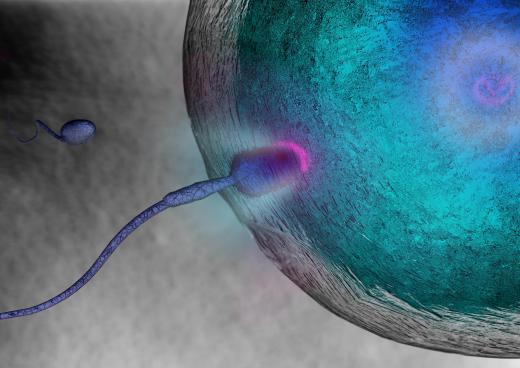What is a Zona Pellucida?
 Niki Foster
Niki Foster
The zona pellucida, formerly called the zona striata, is a membrane surrounding an oocyte, or egg cell, made of glycoprotein. It binds sperm and is essential to the acrosome reaction, which helps a sperm penetrate the egg cell during fertilization. It contains a special glycoprotein, ZP3, that is responsible for these biological functions.
An egg cell, like all animal cells, is surrounded by a plasma membrane, which protects the intracellular components and regulates what materials go into or out of the cell. The zona pellucida is located just outside the egg cell's plasma membrane and is an important part of it. It is composed of three glycoproteins, ZP1, ZP2, and ZP3. ZP3 allows for species specific sperm binding, preventing the sperm of a different species from fertilizing the egg. ZP3 is especially important for animals that have external fertilization, such as fish. ZP2 mediates sperm binding, and ZP1 is important for the structural integrity of the zona pellucida.

During fertilization, the zona pellucida binds sperm by adhering to proteins on its plasma membrane. When this happens, the acrosome, an organelle on the tip of the sperm's head, opens and releases enzymes and antigens enabling it to break through the touch plasma membrane of the oocyte. When a sperm undergoes the acrosome reaction and breaks through the egg's plasma membrane, fertilization occurs.
Male infertility is sometimes due to sperm that fail to undergo the acrosome reaction. Conversely, in some species, some sperm release the contents of their acrosome before reaching the egg, eliminating their own chance of fertilizing the egg, but increasing the motility of other sperm. Premature acrosome reaction is most common in species in which females have many sexual partners, resulting in high competition for the sperm.
After fertilization, the zona pellucida dies and is shed in a phenomenon called zona hatching. It is also necessary to egg cell death in cases when there is no fertilization.
This membrane is sometimes used for population control in certain animals. When animals are injected with the zona pellucida of another species, they are rendered sterile. For example, the zona pellucida of pigs has been used to sterilize the deer population in New Jersey.
AS FEATURED ON:
AS FEATURED ON:











Discussion Comments
is the trophoblastic villi same as chorionic villi?
why the more yolk in vegetal pole will divide slowly than animal pole? what causes this to happen?
Post your comments